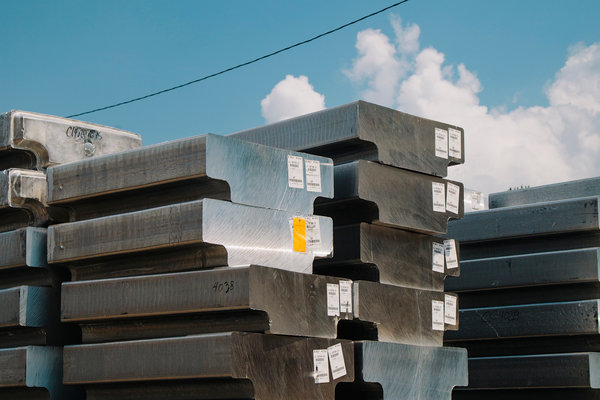David Kocieniewski wins the August Sidney Award for Exposing the Goldman Sachs ‘Metal Merry-go-Round’
David Kocieniewski wins the August Sidney Award for revealing how Goldman Sachs is driving up the price of aluminum by shuffling metal between multiple Detroit-area warehouses to prolong storage times and thereby collect additional rent from the owners of the metal.
When a Goldman Sachs subsidiary bought up over two dozen aluminum storage warehouses in 2010, industrial buyers found themselves waiting four months or more to receive their metal, up from just six weeks before Goldman took over. Since Goldman charges rent to store the metal, many suspected the company was dragging its feet to increase its own profits. The company denied the charge.
Kocieniewski pierced the veil of secrecy surrounding these warehouses to confirm, from interviews with forklift drivers and company records, that Goldman did not prioritize prompt delivery. The warehouses only ran one shift a day. Aluminum arrived by train, but left by truck in a comparative trickle. Goldman even paid metal owners fees to “rewarrant” or move the metal from one warehouse to another, creating additional delays and bottlenecks.
“Kocieniewski’s reporting shows how deregulation created an opportunity for Goldman Sachs to buy up commodities infrastructure and use it to line its own pockets at the expense of manufacturers who need those materials to create goods and sustain jobs,” said Sidney judge Lindsay Beyerstein.
Ultimately, the consumer bears the brunt of these delays in the form of higher prices. “Those costs are ultimately borne by anyone who’s bought a car, a roll of aluminum foil or a can of beer or soda; virtually everyone in the country was paying for it,” Kocieniewski said.
David Kocieniewski is a reporter for the New York Times.

Backstory
- How did you find out that Goldman Sachs was trucking aluminum in an endless circuit between 27 Detroit-area warehouses?
There had been complaints and news reports about long delays at the Detroit metals warehouses since shortly after Goldman bought them in 2010. Before Goldman bought the warehouses, manufacturers typically waited six weeks; by 2011 those delays grew to four months or longer. Because metal owners are charged rent by the day, the delays increase the cost of aluminum, and those costs are passed on to consumers.
Many people were unconvinced by the warehouse’s explanations for the delays — a shortage of trucks and forklift drivers, the logistical complexity of cataloging and moving 1,500 lb bars of metal. But no one had ever been able to pierce the veil of secrecy surrounding the warehouses and figure out the mechanism causing the bottlenecks. After a brief flurry of stories and a promise to address the problem in 2011 from the London Metals Exchange (the industry group that regulates warehouses) the public attention faded.
In the years since, the delays have grown even longer, and the cost to automakers, soda companies mounted. Those costs are ultimately borne by anyone who’s bought a car, a roll of aluminum foil or a can of beer or soda (virtually everyone in the country) was paying for it.
So when the Bizday editors asked me to take a look at the commodities markets, it seemed liked a question worth trying to answer.
- Goldman owns these warehouses and charges rent to house the aluminum. Who owns the metal?
Goldman doesn’t own any of the 1.5 million tons of aluminum stored in its warehouses. Most of that is owned by investors, banks and hedge funds.
- Why is Goldman driving up the price of aluminum? How does the scam work?
Goldman says that its intention isn’t to drive up the cost of aluminum prices. But industry experts and manufacturers insist that whatever Goldman’s intentions, the tactics being used in its Detroit warehouses have added more than $5 billion to the cost of aluminum since 2010.
Goldman’s warehouse makes money by charging aluminum owners rent for storage. That means that the longer it makes metal owners wait for their aluminum, the longer it can charge them and the more money Goldman’s subsidiary makes. Industry regulations only require the warehouses to move a tiny fraction of their metal each day (the minimum load out was 1,500 tons a day until 2011 and was then increased to 3,000 tons), and Goldman says it was logistically unable to move more.
But my reporting — based on interviews with company employees in the offices and the warehouses and documents — found a notable lack of urgency. Most of the warehouses only worked one shift a day and sat idle for the other 16 hours. Forklift drivers said that there was far more effort focused on loading metal into the warehouses than getting it out to customers. Often it arrived by trainload and left in a comparative trickle, in trucks.
In addition, Goldman’s warehouses paid incentives to some to metal owners to “rewarrant” their metal and move it from one warehouse to another. That created bottlenecks and longer lines and forced those waiting for their metal to keep paying. As of last month, the average wait was more than 16 months.
Because of a quirk in the way metal prices are set, the warehouse charges also increase the cost of virtually all aluminum sold in the U.S. — even metal that is never stored in a warehouse.
There are two components to the price of aluminum: the underlying cost of the metal plus a premium added on for storage and transportation costs. The warehouse delays at Goldman’s facilities in Detroit inflated that premium, which has more than doubled since 2010. And the premium is added on to every ton of aluminum sold, whether the underlying price rises or falls.
Even companies that buy their metal elsewhere — like Coca-Cola and MillerCoors — have to pay the higher premium and pass that cost on to consumers.
We calculated that the premium increase attributed to the warehouse delays adds about two cents a case to the cost of soda or beer. That relatively small sum adds up, however, when you consider that Americans consume more than 90 billion canned beverages per year.
- You found that Goldman and other banks are taking advantage of deregulation to pad their commodities profits. Which laws were loosened and why?
For decades, there were very strict laws forbidding banks from engaging in commercial activity. The intention of those laws was to protect depositors, whose funds might be endangered if banks got into overly-risky business ventures. It also was intended to prevent banks from using their financial might to gain an unfair advantage over competitors.
By the 1980s, however, the rise of other, less regulated financial institutions put competitive pressure on investment banks, and Goldman Sachs and other firms won regulatory approval to buy companies that traded in oil and other commodities. Other restrictions were weakened or eliminated during the deregulatory fervor of the 1990s, and the Gramm-Leach-Bliley law in 1999 gave banks that were classified as bank holding companies the authorization to broaden their ownership in infrastructure used to store and transport commodities.
The Federal Reserve also granted Goldman Sachs and Morgan Stanley exemptions from the merchant banking law, allowing them to own warehouses, refineries, pipelines and other hard assets used in the commodities business. Those exemptions are now under review by The Fed.
- Your story has had tremendous impact. Tell us more about the lawsuits and congressional hearings that have come about in the wake of the aluminum revelations.
There were congressional hearings held two days after we published the story. Although the hearings had been scheduled prior to us publishing, the issues raised in the story dominated much of the testimony. Some members of Congress have called for follow-up hearings to delve more deeply into the matter.
The Commodities Futures Trade Commission, a federal regulator, has launched an investigation into possible price manipulation and last week subpoenaed Goldman and owners of other major warehouses for records concerning their aluminum storage practices.
At the request of beverage makers and other manufacturers, the Department of Justice is conducting a preliminary inquiry to determine whether the irregularities at Goldman’s warehouses may have been antitrust violations.
At least two class-action suits have been filed by metals owners, who contend that the Goldman’s warehouse intentionally created bottlenecks and engineered queue-blocking transactions in an improper scheme to overcharge them.
The story has also touched a chord with the public. The Times received more than 1,000 emails from readers about it — the vast majority from people who were outraged that the procedures at Goldman’s warehouse were driving up costs to consumers without adding any value.
It was even featured in a lengthy segment on The Daily Show.


